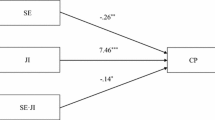Abstract
This paper analyzes the influence of the shadow economy on corruption and vice versa. We hypothesize that corruption and the shadow economy are substitutes in high income countries while they are complements in low income countries. The hypotheses are tested for a cross-section of 98 countries. Our results show that there is no robust relationship between corruption and the size of the shadow economy when perceptions-based indices of corruption are used. Employing an index of corruption based on a structural model, however, corruption and the shadow economy are complements in countries with low income, but not in high income countries.
Article PDF
Similar content being viewed by others
Avoid common mistakes on your manuscript.
References
Aidt, T., & Gassebner, M. (2007). Do autocratic states trade less? Cambridge Working Papers in Economics 0742.
Alesina, A., Easterly, W., Devleeschauwer, A., Kurlat, S., & Wacziarg, R. (2003). Fractionalization. Journal of Economic Growth, 8, 155–194.
Bardhan, P. (1997). Corruption and development: a review of issues. Journal of Economic Literature, 3, 1320–1346.
Bjørnskov, C. (2006). The multiple facets of social capital. European Journal of Political Economy, 22(1), 22–40.
Botero, J., Djankov, S., La Porta, R., Lopez de Silanes, F., & Shleifer, A. (2004). The regulation of labour. Quarterly Journal of Economics, 119, 1339–1382.
Choi, J., & Thum, M. (2005). Corruption and the shadow economy. International Economic Review, 46(3), 817–836.
Djankov, S., La Porta, R., Lopez de Silanes, F., & Schleifer, A. (2002). The regulation of entry. Quarterly Journal of Economics, 117, 1–37.
Dreher, A., Kotsogiannis, C., & McCorriston, S. (2007). Corruption around the world: evidence from a structural model. Journal of Comparative Economics, 35(3), 443–466.
Dreher, A., Kotsogiannis, C., & McCorriston, S. (2008, forthcoming). How do institutions affect corruption and the shadow economy? International Tax and Public Finance.
Dreher, A., & Siemers, L.-H. R. (2009). The nexus between corruption and capital account restrictions. Public Choice, 140(1–2), 245–265.
D’Hernoncourt, J., & Méon, P.-G. (2008). The not so dark side of trust: does trust increase the size of the shadow economy? CEB Working Paper No. 08/030.
Easterly, W., & Sewadeh, M. (2001). Global development network growth database. http://www.worldbank.org/research/growth/GDNdata.htm.
El-Shagi, M. (2005). A legal crime: capital controls as an act of corruption. Mimeo, University of Mannheim.
Friedman, E., Johnson, S., Kaufmann, D., & Zoido-Lobatón, P. (2000). Dodging the grabbing hand: the determinants of unofficial activity in 69 countries. Journal of Public Economics, 76, 459–493.
Gerxhani, K. (2003). The informal sector in developed and less developed countries: a literature survey. Public Choice, 114(3), 295–318.
Gwartney, J., & Lawson, R. (2004). Economic freedom of the world: 2004 annual report. Vancouver: The Fraser Institute. Data retrieved from www.freetheworld.com.
Helberger, C., & Knepel, H. (1988). How big is the shadow economy? A re-analysis of the unobserved-variable approach of B.S. Frey and H. Weck-Hannemann. European Economic Review, 32, 965–976.
Heritage Foundation (2005). Index of Economic Freedom. Washington, DC.
Hibbs, D. A., Jr., & Piculescu, V. (2005). Institutions, corruption and tax evasion in the unofficial economy. Göteborg, Department of Economics.
Hindriks, J., Muthoo, A., & Keen, M. (1999). Corruption, extortion and evasion. Journal of Public Economics, 74, 395–430.
La Porta, R., Lopez de Silanes, F., Shleifer, A., & Vishny, R. W. (1999). The quality of government. Journal of Law, Economics, and Organization, 15(1), 222–279.
Johnson, S., Kaufmann, D., & Shleifer, A. (1997). The unofficial economy in transition. Brookings Papers on Economic Activity, 2, 159–221.
Johnson, S., Kaufmann, D., & Zoido-Lobatón, P. (1998). Corruption, public finances and the unofficial economy. World Bank Policy Research Working Paper Series 2169.
Kaufmann, D., Kraay, A., & Mastruzzi, M. (2003). Governance matters III: Governance indicators for 1996–2002. World Bank Policy Research Working Paper 3106.
Klitgaard, R. (1988). Controlling corruption. Berkeley: University of California Press.
Loayza, N. V. (1996). The economics of the informal sector: a simple model and some empirical evidence from Latin America. Carnegie-Rochester Conference Series on Public Policy, 45, 129–162.
Marshall, M. G., & Jaggers, K. (2008). Polity IV project: political regime characteristics and transitions, 1800–2008. http://www.systemicpeace.org/polity/polity4.htm.
Méon, P.-G., & Sekkat, K. (2004). Does the quality of institutions limit the MENA’s integration in the world economy? The World Economy, 27(9), 1475–1498.
Méon, P.-G., & Sekkat, K. (2005). Does corruption grease or sand the wheels of growth? Public Choice, 122(1–2), 69–97.
Méon, P.-G., & Weill, L. (2006, forthcoming). Is corruption an efficient grease? World Development.
Mocan, N. (2004). What determines corruption? International evidence from micro data. NBER Working Paper 10460.
Otáhal, T. (2007). Why is corruption a problem of the state? Prague Economic Papers, 2, 165–179.
Pitlik, H., Frank, B., & Firchow, M. (2009, forthcoming). The demand for transparency: an empirical note. Review of International Organizations.
Rose-Ackerman, S. (1999). Corruption and government: Causes, consequences and reform. Cambridge: Cambridge University Press.
Schneider, F. (2005a). Shadow economies of 145 countries all over the world: estimation results of the period 1999–2003. University of Linz: Department of Economics, Discussion paper Linz, Austria.
Schneider, F. (2005b). Shadow economies around the world: what do we really know? European Journal of Political Economy, 21(3), 598–642.
Schneider, F., & Enste, D. H. (2000). Shadow economies: size, causes, and consequences. Journal of Economic Literature, 38, 77–114.
Shleifer, A., & Vishny, R. W. (1993). Corruption. Quarterly Journal of Economics, CVIII, 599–618.
Søreide, T. (2005). Is it right to rank? Limitations, implications and potential improvements of corruption indices. Paper presented to IV Global Forum on Fighting Corruption and Safeguarding Integrity, Session Measuring Integrity, June 7, 2005.
Weber Abramo, C. (2005). How far perceptions go. Transparency Brazil Working Paper.
World Bank (2003). World development indicators. CD-Rom, Washington, DC.
Author information
Authors and Affiliations
Corresponding author
Rights and permissions
Open Access This is an open access article distributed under the terms of the Creative Commons Attribution Noncommercial License (https://creativecommons.org/licenses/by-nc/2.0), which permits any noncommercial use, distribution, and reproduction in any medium, provided the original author(s) and source are credited.
About this article
Cite this article
Dreher, A., Schneider, F. Corruption and the shadow economy: an empirical analysis. Public Choice 144, 215–238 (2010). https://doi.org/10.1007/s11127-009-9513-0
Received:
Accepted:
Published:
Issue Date:
DOI: https://doi.org/10.1007/s11127-009-9513-0




